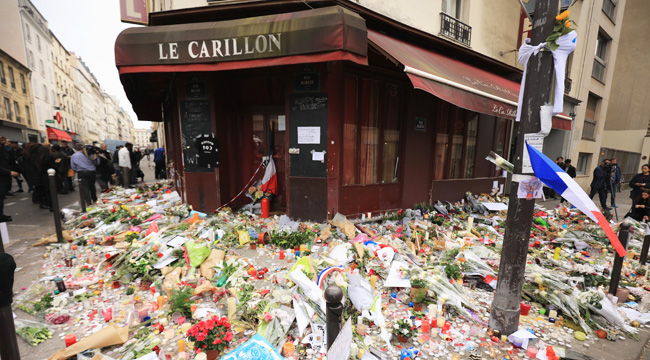
Paris still remains in various stages of recovery after last November’s coordinated, multi-site terror attack. The Bataclan venue (where 89 people died while attending an Eagles of Death Metal show) has not yet reopened but will do so this fall after extensive repairs. The Le Carillon cafe (where 15 people died) reopened two months after the attacks in what was seen as “act of defiance, but also of resilience.” The full attack, which killed 130 people and left many more injured, could have been even worse if ISIS had its way.
A new CNN report finds that ISIS originally planned a more widespread, bloodier event. The cable news network gained access to “[90,000] pages of documents and photos from internal European investigations,” which also indicated follow-up attacks outside of France and even overseas. At least eight Paris attacks suspects were taken into custody following the November terrorism. The documents also discuss two other suspected ISIS operatives — Adel Haddadi (of Algeria) and Muhammad Usman (of Pakistan) — who were captured before reaching France, where they were reportedly intent upon further attacks. They likely planned to meet up with another operative, Abid Tabaouni, who remained free in Paris until his July arrest in Belgium.
CNN posted a map of Haddadi and Usman’s travel route, which began in Raqqa, Syria, and included a month-long detainment in Greece. They masqueraded as Syrian refugees and arrived in Austria on the day after the Paris attacks. Yet — and this is sobering — the two men originally belonged to a group of four operatives. Two of the members went on to help execute the Paris attacks (as suicide bombers who detonated their explosives outside a stadium in Paris), but Haddadi and Usman’s fake passports were detected in Greece. Authorities believe this was the reason they never made it to Paris on time, so they remained in the Austrian refugee center until their December arrests. Investigators traced a mountain of electronic information to find that they were guided by a “shadowy ISIS leader in Syria” known as a Abu Ahmad.
Investigators also uncovered other ISIS attack plans that revealed how additional locations throughout Paris — including shopping districts and a supermarket — were targeted, though CNN doesn’t specify whether these targets were intended for follow-up strikes or as part of the original multi-site attack plan. The documentation revealed that, as a whole, the group that did attack Paris was “a slimmed-down version of an even more ambitious plan to hit Europe.” ISIS also reportedly intended to attack targets in the Netherlands and the United Kingdom.
CNN also cautions that ISIS has polished its coordination skills — likely in large part to recently killed spokesman Abu Muhammad al-Adnani — and the notion of a “Jihadi help desk” is more than a real deal. Terror analyst Paul Cruickshank told CNN that ISIS is “increasingly sophisticated in the way it does this. It’s set up an intricate, logistical support system for these terrorists.” ISIS embraces encryption, and operatives remain relatively blind to full plans until their mysterious handlers grant them “information and money as they need to reach the next phase.” This limits the potential for discovery, and while ISIS’ maneuvers certainly aren’t foolproof, the threat of undiscovered future plots and operatives seems almost certain.
The full CNN piece includes plenty of detail, including the infighting, paranoia, and communications methods used by the three ISIS operatives who never made it to the Paris attack sites.
(Via CNN, The Guardian & NBC News)
